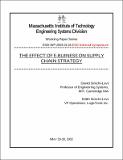| dc.contributor.author | Simchi-Levi, David | |
| dc.contributor.author | Simchi-Levi, Edith | |
| dc.date.accessioned | 2016-05-31T19:00:08Z | |
| dc.date.available | 2016-05-31T19:00:08Z | |
| dc.date.issued | 2002-05 | |
| dc.identifier.uri | http://hdl.handle.net/1721.1/102732 | |
| dc.description.abstract | Internet technology has forced companies to redefine their business models so as to improve the extended enterprise performance - this is popularly called e-business. The focus has been on improving the extended enterprise transactions including Intraorganizational, Business-to-Consumer (B2C) and Business-to-Business (B2B) transactions. This shift in corporate focus allowed a number of companies to employ a hybrid approach, the Push-Pull supply chain paradigm. In this article we review and analyze the evolution of supply chain strategies from the traditional Push to Pull and finally to the hybrid Push-Pull approach. The analysis motivates the development of a framework that allows companies to identify the appropriate supply chain strategy depending on product characteristics. Finally, we introduce new opportunities that contribute and support this supply chain paradigm. | en_US |
| dc.language.iso | en_US | en_US |
| dc.publisher | Massachusetts Institute of Technology. Engineering Systems Division | en_US |
| dc.relation.ispartofseries | ESD Working Papers;ESD-WP-2003-01.04-ESD Internal Symposium | |
| dc.title | The Effect of e-Business on Supply Chain Strategy | en_US |
| dc.type | Working Paper | en_US |
